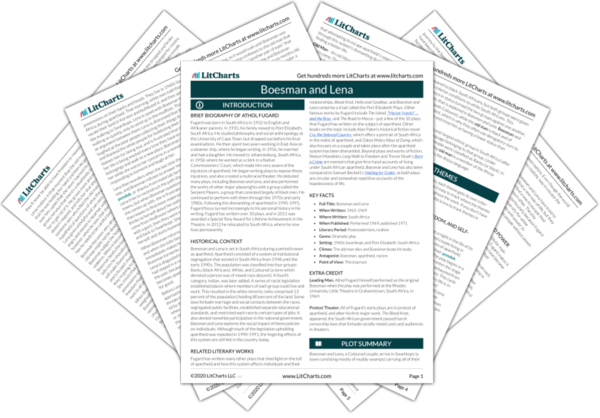Oppression, Freedom, and Self-Worth
Boesman and Lena centers on a night in the life of its two title characters, a Coloured couple living in 1960s South Africa. Facing the brutal policies of apartheid, Boesman and Lena have been forced out of their pondok (shanty) by a white man bulldozing the land. The play begins in a visceral way: the two overburdened characters enter the stage carrying everything they own to a new location, exhausted from their journey and…
read analysis of Oppression, Freedom, and Self-WorthViolence, Cruelty, and Power
Although Boesman and Lena, the titular main characters of the play, are a couple, Fugard makes it immediately clear that the characters have become largely devoid of affection for each other. As they feel powerless to fight their arduous circumstances in apartheid-era South Africa, they bicker, taunt, and abuse each other, as well as the old man who wanders into their camp in the middle of the night. Over the course of the…
read analysis of Violence, Cruelty, and PowerRacism and Status
Boesman and Lena are living in apartheid-era South Africa, in which people were classified and segregated based on their race, with white South Africans (mostly of Dutch descent, known as Afrikaners) holding a vast majority of the land and wealth, despite being a very small minority of the population. Apartheid is a prime example of institutionalized racism, with extensive laws supporting the oppression of Coloured people (mixed-race South Africans) and Bantus (black South Africans)…
read analysis of Racism and Status
Connection vs. Isolation
Boesman and Lena’s circumstances have left them with very little connection and intimacy, as they constantly argue over their present circumstances. As a result, both of them, but Lena in particular, search for a sense of connection in order to remedy their feelings of isolation. Fugard demonstrates that connection is vital to the characters because it is a way of being witnessed, and a means of acknowledging that they have lived—a concept that is…
read analysis of Connection vs. Isolation






